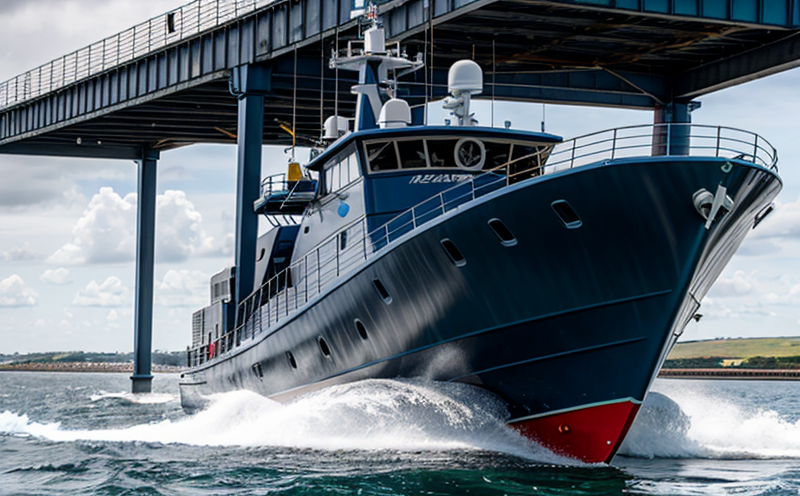ISO 6336 Gear Load Capacity Testing of Marine Transmissions
The ISO 6336 standard is a cornerstone in the marine industry, providing specifications and test methods for gear load capacity determination. This service focuses on ensuring that marine transmissions meet or exceed specified performance criteria under defined conditions. The primary purpose is to validate the structural integrity and operational reliability of gears used in marine engines and propulsion systems.
The testing process involves subjecting gear components to a series of loading cycles that simulate real-world operating conditions. These tests are conducted using specialized equipment capable of simulating various load scenarios, including static and dynamic loads, which can vary significantly depending on the vessel type and operational environment.
Proper specimen preparation is critical for accurate testing results. This includes cleaning, inspecting, and ensuring that all gear components are free from contaminants or defects before being placed in the test rig. The use of advanced lubricants and greases as specified by ISO 6336 ensures realistic load transfer conditions.
The testing apparatus typically comprises a hydraulic loading system, a precision encoder for monitoring rotational speed, and sensors to measure torque, displacement, and temperature changes during each test cycle. Data collection is continuous throughout the process, allowing for real-time adjustments if necessary. Compliance with ISO 6336 standards ensures that all tests are conducted under controlled conditions, minimizing variability in results.
Post-test analysis involves evaluating the gear's resistance to wear, fatigue, and other forms of degradation. This data helps determine whether the transmission can withstand expected operational stresses without failure. The report generated from this process provides detailed insights into the performance characteristics of each tested component, which is invaluable for quality assurance purposes.
Accurate documentation of test procedures and results aligns with best practices outlined in ISO 6336. This includes maintaining records of all environmental factors present during testing (temperature, humidity) as well as operator notes on any deviations from standard protocols. Such thorough documentation enhances traceability and supports continuous improvement efforts.
By adhering strictly to these standards, manufacturers can ensure their products meet stringent quality benchmarks set forth by international authorities. This not only builds trust among clients but also facilitates smoother regulatory compliance processes across different jurisdictions.
In summary, ISO 6336 gear load capacity testing plays a vital role in safeguarding the longevity and efficiency of marine transmissions. Through rigorous evaluation procedures, this service contributes significantly towards maintaining high standards within the industry.
Quality and Reliability Assurance
- Data Accuracy: Continuous data collection ensures precise measurement of all relevant parameters during testing cycles.
- Environmental Control: Test conditions are strictly regulated to mimic actual operational environments accurately.
- Component Durability: Rigorous evaluation procedures assess the ability of gear components to withstand specified loading conditions successfully.
- Regulatory Compliance: Testing adheres meticulously to ISO 6336 guidelines, ensuring adherence to international standards.
These elements collectively contribute to enhancing overall product quality and reliability, thereby supporting long-term customer satisfaction and operational efficiency.
Environmental and Sustainability Contributions
The application of ISO 6336 gear load capacity testing promotes sustainable practices by fostering the development of robust marine transmissions. These components play a crucial role in optimizing fuel consumption, reducing emissions, and minimizing environmental impact. By ensuring that gears perform optimally under extreme conditions, manufacturers can design more efficient engines which contribute positively to global sustainability goals.
Additionally, rigorous testing helps identify potential areas for improvement, encouraging innovation aimed at creating greener technologies. This approach supports the maritime sector's transition towards cleaner energy solutions while maintaining operational excellence.
Competitive Advantage and Market Impact
Adopting ISO 6336 gear load capacity testing offers several advantages that can differentiate businesses in a competitive market:
- Innovation Leadership: Continuous adherence to cutting-edge standards positions companies at the forefront of technological advancements.
- Premium Reputation: Meeting international quality benchmarks enhances brand image and fosters strong customer relationships.
- Reduced Downtime: Reliable equipment leads to fewer breakdowns, resulting in increased productivity and lower maintenance costs.
- Enhanced Customer Confidence: Transparent testing processes build trust with stakeholders, fostering repeat business opportunities.
The implementation of this service demonstrates a commitment to excellence, setting the stage for sustained growth within the industry.





